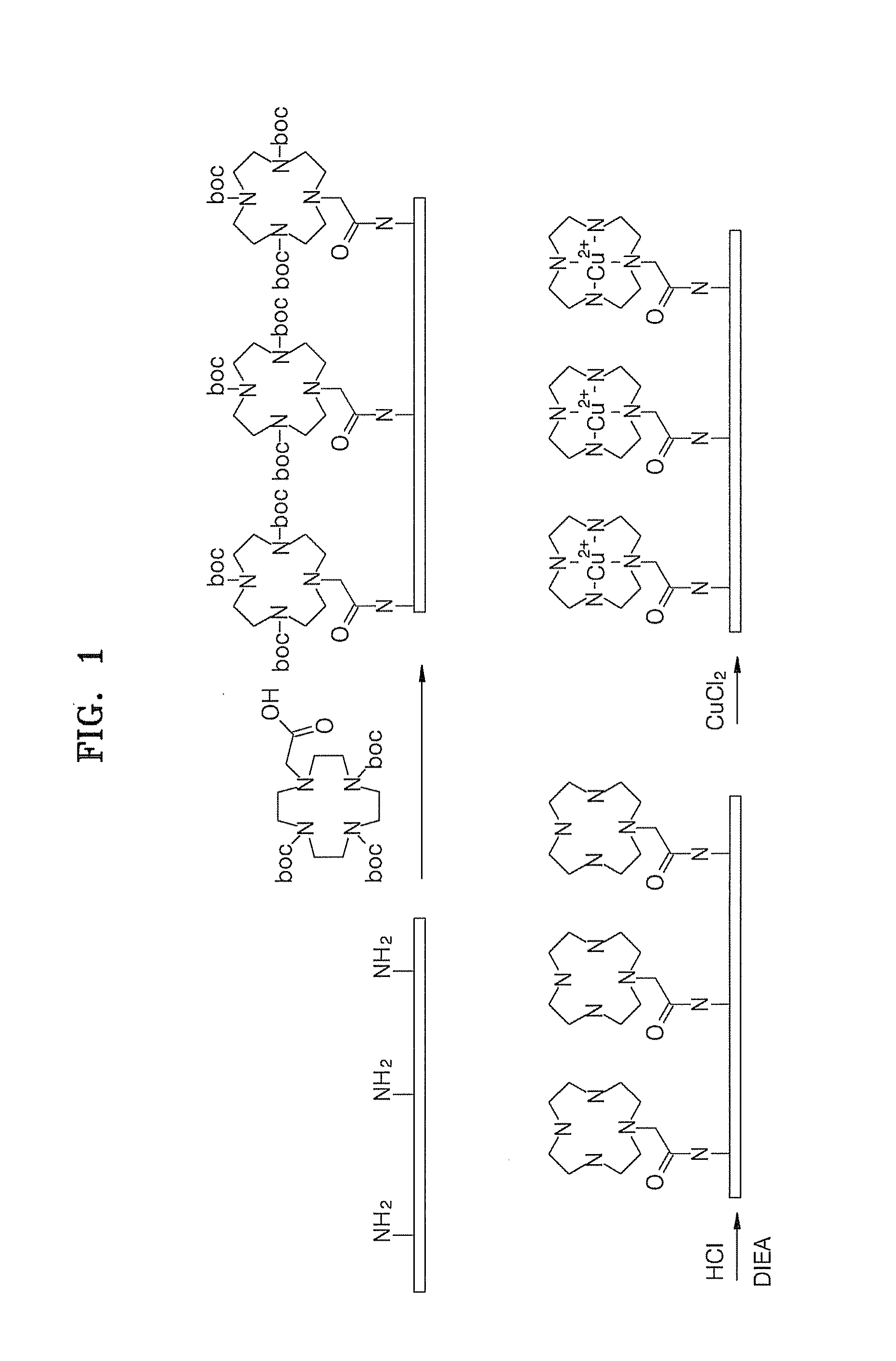Cell lysis method by immobilized metal-ligand complex
a cell lysis and metal ligand technology, applied in the field of cell lysis methods by immobilized metal ligand complexes, can solve the problems of reducing the number of steps upon loc implementation, affecting the amplification of dna, and protein denaturation that can stick to the released dna, so as to achieve the effect of reducing the number of steps
- Summary
- Abstract
- Description
- Claims
- Application Information
AI Technical Summary
Benefits of technology
Problems solved by technology
Method used
Image
Examples
preparation example 1
Immobilization of a Metal-Ligand Complex on a Substrate
[0061]To immobilize a metal-ligand complex on a substrate activated with an amino group, a glass substrate coated with -aminopropylsilane was used. 0.5 g of Cyclene protected by boc (t-butoxycarbonate) as a ligand and 0.2 g of HBTU were dissolved in 5 mL of DMF, and then the resulting solution was added to the glass substrate to immobilize the ligand on the substrate. Then, 5 mL of 0.1 M HCl was added to the substrate to remove the boc, the protecting group. The substrate was treated with 10% diisopropyleneamine solution to remove any salt. A solution of 0.1 g of CuCl2 in DMF was added to the substrate to prepare a Cu-cyclene complex.
preparation example 2
Immobilization of a Metal-Ligand Complex on a Bead
[0062]To immobilize a metal-ligand complex on a bead, a polystyrene bead was used. 0.1 g of cyclene as a ligand and 10 mL of a solution of 10 μl of diisopropylethylamine in dimethylformamide were added to 1 g of a polystyrene bead activated with chloromethyl (Aldrich) to immobilize the ligand on the styrene bead. Then, a solution of 0.1 g of CuCl2 in DMF was added to the bead to bind Cu2+ to the cyclene, thereby preparing a Cu-cyclene complex immobilized on the bead.
preparation example 3
Bacteria, Primer and Polymerase Chain Reaction (PCR)
[0063]E. coli strains DH5α (3 mL), which were transformed with plasmids recombined with the HBV gene, were cultured at 37° C. with vigorous aeration in LB media (Sambrook et al., 1989) to exponential phase (OD600=0.64). The bacterial cells were collected by centrifugation and twice washed with 3 mL of a phosphate buffered saline (PBS). The cells were resuspended in PBS (cell density: 1×106 cells / mL).
[0064]All PCRs were performed using the LightCycler instrument (Roche Diagnostics, Mannheim, Germany) in 20 μl. A forward primer (SEQ ID No: 1) and a reverse primer (SEQ ID No: 2) were used to amplify a core region of the HBV genome. A mastermix in the LightCycler reaction was prepared as follows: 2 μl LightCycler master (Fast start DNA master SYBR Green I; Roche Diagnostics), 3.2 μl MgCl2 (5 mM), 1.0 μl forward-reverse primer mix (1.0 μM), 4.0 μl UNG (Uracil-N-Glycosylase, 0.2 unit), and 4.8 μl H2O. 5 μl of the samples to be tested wer...
PUM
| Property | Measurement | Unit |
|---|---|---|
| pH | aaaaa | aaaaa |
| pH | aaaaa | aaaaa |
| pH | aaaaa | aaaaa |
Abstract
Description
Claims
Application Information
 Login to View More
Login to View More - R&D
- Intellectual Property
- Life Sciences
- Materials
- Tech Scout
- Unparalleled Data Quality
- Higher Quality Content
- 60% Fewer Hallucinations
Browse by: Latest US Patents, China's latest patents, Technical Efficacy Thesaurus, Application Domain, Technology Topic, Popular Technical Reports.
© 2025 PatSnap. All rights reserved.Legal|Privacy policy|Modern Slavery Act Transparency Statement|Sitemap|About US| Contact US: help@patsnap.com



